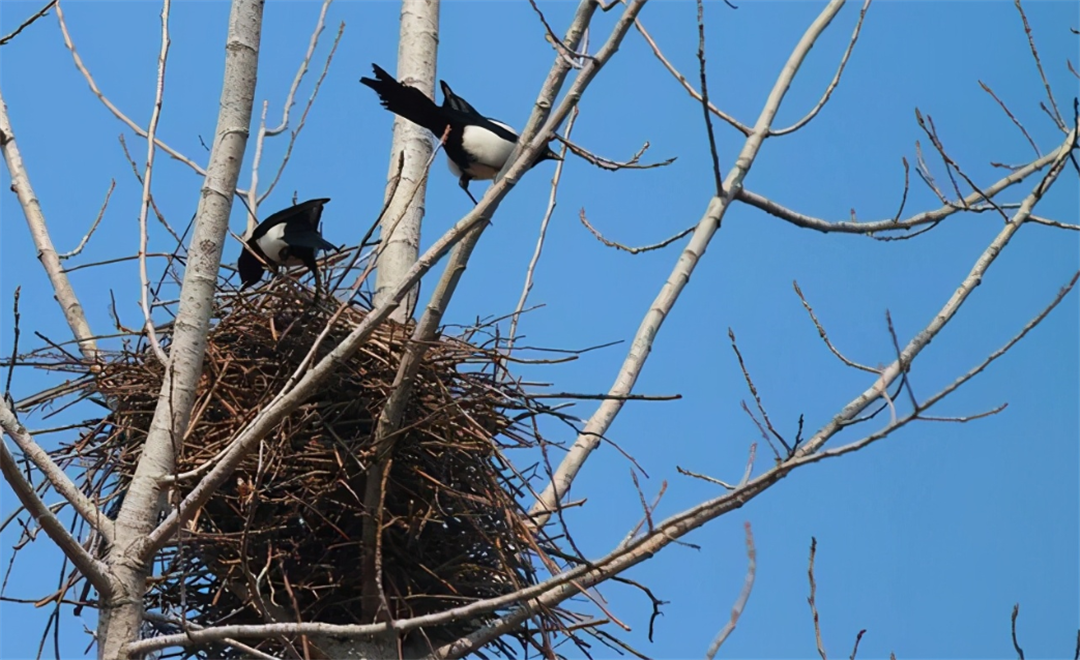Wen | Science Popularization Institute
Magpies and crows belong to the same family of crows, but their treatment in the hearts of the Chinese people is very different, the latter is regarded as a sign of bad luck, and the former is used to express expectations and good feelings.

If you look closely, you will find that magpies often nest on large trees, looking simple and rough, like a mess of branches that can no longer be messed up. Can such a bird's nest really shelter these birds from the wind and snow?
There are a total of 10 subspecies of magpies, of which 4 are subspecies in China. This bird is widely distributed throughout the world, distributed throughout our country, belongs to the resident bird, does not migrate with the seasons.
Image source: Bird Net
The magpie is about 40-50 cm long, the head, neck, back, and feathers are black, and it will show purple, greenish blue and other lusters from front to back, with white spots on the wings and shoulders, and white abdomen.
Magpies are very adaptable, whether they are mountains, plains, farmland, cities, they are found. And the more densely populated the human activity, the greater the magpie population.
Although they are very close to human life, they are still very alert when they forage. Except during breeding, magpies usually move in small groups of 3-5, and in autumn and winter, they will gather in large groups of dozens of them, and there will be members as "guards" when foraging.
They eat a variety of food, mainly insects and other animal foods in summer, including locusts, scarab beetles, bugs, etc.; in other seasons, they mainly eat the fruits and seeds of plants.
Unfortunately, magpies also catch small birds to eat, and even eat the carcasses of some animals. During breeding, if other creatures break into their territory, it is not surprising that they will be violently attacked. In Australia, every year someone is pecked by a magpie.
In order to breed broods, magpies expend a lot of energy to build nests. However, when many people see the magpie's nest, they can't help but say "That's it?" The question, in fact, the magpie's nest is not as simple as it seems.
There is a French proverb that "humans can imitate anything except the nest" to praise the delicacy of the nest, and the magpie's nest fully deserves such praise.
The reason why the magpie's nest is not afraid of wind and snow is because the interior of the nest is "not a hole in the sky", which looks tattered, but inside is a luxury villa.
Every year in the cold winter, magpies begin to collect materials to build nests, and both males and females participate. The male magpie is more physical and will take on more transportation responsibilities, such as transporting some thick branches.
The magpie's nest is particularly located, neither nesting under human eaves like swallows, nor being as far away from people as many birds. According to one survey, more than half of the magpie nests are surrounded by buildings, and most of them are no more than 20 meters away.
Choosing to nest on trees next to tall buildings helps protect the nest. They will choose to build their nests at a height that is a certain distance from the top of the tree, both to avoid the noise of the ground and to avoid wind and rain with the branches.
However, even the most leafy trees cannot perfectly shelter the nest from all the wind and snow, and the rest is up to the magpies themselves. Magpies are nature's top architects with superb nesting skills.
Magpie nests are mostly ovate in shape and have a cover on top. In layman's terms, the magpie's nest can be divided into three layers, and the outer layer is the dead branches that we can see with the naked eye, which looks sloppy and messy;
In the middle is a mud bottom shaped like a plate; the innermost layer is a "mattress" made of soft substances such as feathers and grass roots, which is cushioned on the dirt to make it comfortable and warm.
The overall structure of the magpie's nest reveals the wisdom of these little guys, not only the top has a rainproof cover, but also 2-3 openings on the side, which can flexibly choose the leeward opening according to the wind direction, and temporarily seal the wind from the opening without the use.
Magpies are birds that have evolved with the times, and as urbanization has accelerated, some birds have had to leave, but magpies have been able to continue to take root in the city.
As a result, we occasionally see magpie nests made of wire, some of which are also built on high-pressure poles. The magpie's nest is large and comfortable, and in the eyes of those birds who are not good at nesting, it is a good "nest".
The idiom "dove occupies the magpie's nest" originally meant that the dove that could not make a nest encroached on the magpie's nest. In addition to forcible encroachment, some abandoned old nests of magpies will also be inhabited by some beneficial birds of prey.
————————————
The pictures in this article come from the network, if there is infringement, please contact to delete